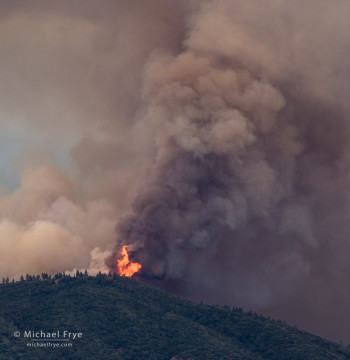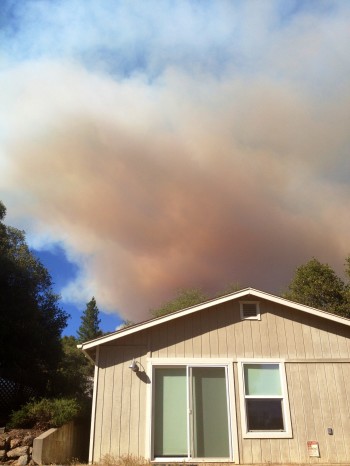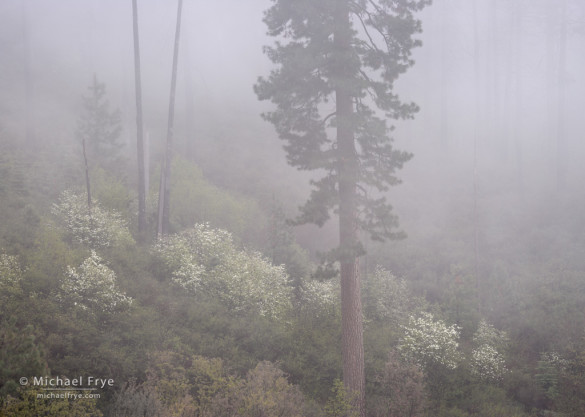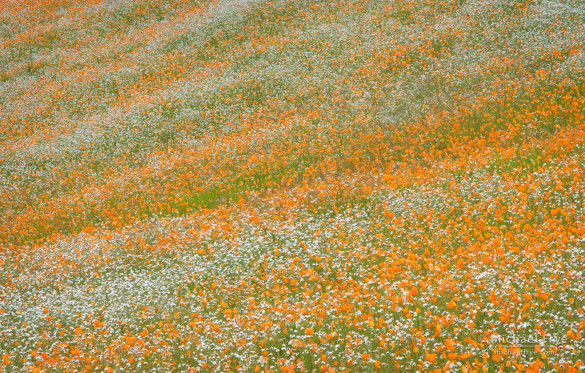We live in a fire-prone area, and we’ve had two dry years in a row. On Sunday afternoon a fire broke out about three miles from our house in Mariposa. Named the Carstens Fire, it started from a neglected campfire and quickly spread, pushed by winds and fueled by dry brush, grass, and timber.
I first heard about the fire when my wife Claudia called me on Sunday afternoon. She was in Fresno, and had received a call from a friend about the fire. I went outside, and from our driveway could see smoke to the north, so I got in my car and went on a reconnaissance. The good news was that the fire was about three miles away – close, but not an immediate threat. The bad news was that it was already a sizable fire, and the wind was blowing it towards our house.
We packed the essentials in case we were evacuated: computers, hard drives, important papers, valuables, mementos, clothes, supplies for our dog and cats. But the wind seemed to shift a bit, taking the smoke, and the fire, more to the east. We heard about evacuations in the Jerseydale area, about five miles to the northeast of us, but evacuation didn’t seem imminent for us. After sunset we went on another reconnaissance drive, and were mesmerized by the beautiful, eerie, orange glow behind ridges to our north.
Monday started quietly, but by three in the afternoon the winds had picked up again, and from our driveway we could see a huge mushroom cloud of smoke to the northeast. Again we drove to a spot where we could get a better view, and saw giant flames leaping hundreds of feet into the air from the top of Buckingham Mountain (shown in the photograph above; the pines to the left of the flames are at least 75 feet tall).
The winds were taking the fire to the east, away from our house, so we felt safe. But we knew that houses in Jerseydale and Lush Meadows were right in the path of the fire. News reports that evening said that the fire was only 15% contained and had reached 1600 acres in size. By then 800 homes were under a mandatory evacuation order.
Yet late in the day the winds calmed, and the fire lay down. At our house, Tuesday morning was calm, with crystal clear blue skies, and no smoke in sight. Another afternoon reconnaissance revealed few signs of a fire. The inferno on Buckingham Mountain was gone, with only some wisps of smoke emanating from the far side of the ridge. By the end of the day, even though the fire was only 40% contained, the fire crews were talking about mop-up operations. Today the number of personnel on the fire dropped from 2,200 to 1,200. The fire isn’t out yet, but it seems that firefighters have a good handle on it. Thankfully no homes were destroyed.
Claudia and I have lived in these mountains for 30 years, and we’ve seen fires every summer. It’s unnerving to have a big wildfire spring up so suddenly, so close to our house, but it’s not a surprise, especially in this dry year. Fires are something you learn to live with around here.
It’s incredibly sad when someone loses their home in a fire, and even worse when someone is injured or killed. But I’ve lived in these mountains long enough to also appreciate how fire brings rebirth and renewal.
In August of 1990, nearly-simultaneous lightning strikes ignited the massive A-Rock and Steamboat fires on the western edge of Yosemite National Park. 45 structures were destroyed in Foresta, and many people lost everything they owned. Yosemite historian Shirley Sargent lost not only her home, but all her historical papers.
Our son Kevin was born during these fires. We lived in Yosemite Valley then, and the valley was closed to visitors for three weeks until the fires were contained. We had to get special permission from the park service to drive out Highway 120 – open only to administrative traffic at the time – when Claudia went into labor.
The heat from the A-Rock Fire was so intense that rock surfaces became fused in some areas. Yet the next spring flowers bloomed in abundance in these same places, and the oaks were crown-sprouting – shooting up new branches and leaves from their still-intact root systems. Within a few years a thick crop of oaks and dogwoods had sprung up in areas burned by the Steamboat Fire. The photograph below, which I posted last month, was made in one of these burned areas; the young trees, including the dogwoods, are Kevin’s age.
In 2008 the Telegraph Fire reached within three miles of our Mariposa house. Our home was never really threatened, but the fire spread to 34,000 acres, and 30 homes were destroyed. And then the next spring some of the burned areas exploded with poppies, leading to the most spectacular bloom in memory in the Merced River Canyon. Even areas that didn’t get burned got a dose of fertilizer from the fire’s ash, leading to exceptional poppy blooms in 2009 and 2012.
I try to keep things in perspective. I know that fire is part of the natural cycle of life around here, and necessary for healthy forests and ecosystems. It can even be a boon to photographers who love wildflowers. But fires are also highly destructive. It’s only June, and we have a long, hot, dry summer ahead of us. Like many other people throughout the western United States, we’ll be on edge until the the fall rains arrive. Let’s hope the fire season isn’t as bad as it’s expected to be.
— Michael Frye
P.S. Thanks to all of you who wrote to express your concern about the fire, and wish Claudia and I well – we really appreciate that. I know many of my readers live in fire country, and I hope you all make it through this summer unscathed.
Also, Troy Montemayor posted an amazing photograph of the Carstens Fire from Sunday evening on Flickr.
Related Posts: Spring Continues in Yosemite; Redbud and Poppies; Merced River Poppies
Michael Frye is a professional photographer specializing in landscapes and nature. He is the author and photographer of The Photographer’s Guide to Yosemite, Yosemite Meditations, and Digital Landscape Photography: In the Footsteps of Ansel Adams and the Great Masters, plus the eBooks Light & Land: Landscapes in the Digital Darkroom, and Exposure for Outdoor Photography. He has written numerous magazine articles on the art and technique of photography, and his images have been published in over thirty countries around the world. Michael has lived either in or near Yosemite National Park since 1983, currently residing just outside the park in Mariposa, California.













I am so delighted to hear that you, your family, neighbours and your homes are all safe.
It doesn’t matter how clever we become as humans we can never outsmart Mother Nature! I live on an island prone to hurricanes so I understand your concern!
Fingers crossed that there are no more natural disasters for anyone.
Claire
Thanks Claire – stay safe from those hurricanes!
Glad you and family are safe! I had a shoot in Bakersfield the day after the fire started. The smoke was hugging the Sierras and foothills all the way there.
Thanks for the good wishes Al!
Hi Michael, we heard about these fires back here in “Oz” and wondered how things were going. So pleased you got through the worst of it. The top image is graphic with those flames so high and menacing.
We did wonder why there are fire pits at camping areas at all, are they necessary? The amount of smoke that consumes the clean air surprised us. When we were camping up at Hodgdon Meadow we could barely draw breath. Maybe get rid of them entirely, campers these days have access to gas stoves for cooking and thermal gear for cold!
Thanks Barbara. I think many people in the park service would agree with you — off the record — about campfires, and not just because of the potential to start fires (which I can’t remember ever happening from a campfire in the national park), but because of the air pollution. But people love campfires. They add a lot to the camping experience, and people would be up in arms if they weren’t allowed to have campfires. I admit that I like them too, in the right circumstances. For what it’s worth, the campfire that started this fire was not in the national park, and not in a designated campground. In fact it was probably an illegal campfire, since fires are not allowed outside designated campsites in the national forest (where this started) during fire season.
I hope that you are keeping your off-site backups up to date, although running away clutching your computer with the fire at your heals sounds like an interesting back up plan!
Stay safe, my friend.
Thanks Eric. Off-site backups are a real issue. Mine is not as up-to-date as it should be, but cloud backup is impractical due to the amount of data.
Michael and Claudia,
So glad you are both safe. Last year I emailed you that my wife and I were evacuated for three days due to the Waldo Canyon Fire which was , until last week, the most destructive fire in Colorado history destroying 346 homes. The Black Forest Fire has, at last count, destroyed 509. Both fires have been within a few miles of our house and both were man-made although accident or arson have not yet been determined. There are a few other fires in the state, some (like the Big Meadow Fire in Rocky Mountain National Park) were lightning induced. That “orange cloud” you mentioned enveloped our entire home last year just prior to our reverse 911 notification to evacuate immediately.
Just a couple of weeks ago we drove up into the Mountain Shadows area where the 346 homes were destroyed by Waldo and the regrowth – and rebuilding – was a joy to see. Black Forest hopefully will do the same. It WAS the largest old growth area of Ponderosa Pine trees in the nation according to some reports.
Fires are the norm in the west and nature will recover whether the fires were human or natural in origin. But human cause is more concerning. I think we need to heed the old Smoky the Bear warning of “Only YOU can prevent forest fires”.
Thanks James for the good wishes, and for sharing your fire stories. I’ve seen those orange clouds of smoke many times now, but luckily have never been enveloped in one. I’m glad your house survived, and it’s good to hear about the regrowth and rebuilding in your area.
Unfortunately, manmade fires are hard to stamp out. Accidents happen, and arsonists will do their thing for whatever twisted reasons. Both of the fires closest to our house here in Mariposa — this Carstens Fire, and the Telegraph Fire in 2008 — were human caused, but accidental. The Telegraph Fire was started by someone target shooting. He was eventually convicted of a misdemeanor, but only, as I understand it, because he was using the wrong type of ammunition. Otherwise what he was doing was legal — if not particularly smart. This Carstens Fire was started by an unattended campfire. I think the location of the campfire was illegal, and certainly leaving it unattended was illegal. Apparently they threw dirt over it, but not water, and obviously didn’t make sure it was completely out. But I doubt whoever made this campfire will be found.
Hi Michael,
So good to hear that you are all fine and safe. 2008 Oliver Fire was less than two miles from us, directly down the Chowchilla Mountain Rd. I remember you were in a LA Times picture during Telegraph Fire the same year, or LA Times used one of your picture? I think I should simply leave my lenses in the car from now until winter. I hope those campers would be punished.
Always appreciate your images.
Sharon
Thanks for the good wishes Sharon, and I’m glad the Oliver Fire didn’t reach your house. Yes, a photographer from the L.A. Times took a photograph of me taking a photograph of the Telegraph Fire.
I recommend a “fire safe” for the disk drives…got mine from Costco…supposedly it withstands 1700 degrees…
It does not protect from burglars, nor is it for cassettes 🙂 just hard drives, memory sticks, et.al.
Regards..Relishguy
Thanks for the suggestion Roger. I guess I don’t entirely trust a fire safe to keep my hard drives safe during a fire. If it gets really hot, even if the safe doesn’t burn, wouldn’t the things inside it melt? I’m not sure what temps a hard drive can withstand.
I’ve had the same thoughts about how hot it would get inside the 1-hour 1700 degree fire proof safe. In a city, fire fighters could douse the fire in less than 1 hour. That time frame could be much longer in a non-city area.
Off-site or an underground fire proof storage area are other ideas.
Dear Michael,
I had read about the fires near your home and was hoping that you and Claudia were okay. So glad to hear that no home have been lost. I hope, as dry as it has been, that no other fires come your way.
Thank you Vivienne. I’m also glad no homes have been lost in this fire, though I know many homes have been lost in other fires in Colorado and California recently.
Too close for comfort… We are hoping for a wet monsoon season in AZ
Jerry, I hope you do get a wet monsoon season — with no dry lightning!
So glad Claudia and you are safe and your home spared from that fire. I was wondering how close that fire was to your home when I first heard about it. Really worried about the fire season this year due to our low rainfall this year.
It was also very nice seeing Claudia and you up there in the redwoods. Was an incredible morning that day and I enjoyed later hiking all the way to the ocean and back. The fog was gone quickly the next day as the bright full sunshine took over and the wind picked up. Look forward to seeing some more of your great images from up there.
Thanks very much Wayne. It was nice to run into you up in the redwoods — small world! At least for photographers. 🙂 Glad you enjoyed that day.
Howdy. Glad you guys fared well. Pretty exciting, eh?
Yesterday I went to the online site where you can look at an ArcGIS map of Carstens Fire and measured the distance from the closest part of the fire to my house: 1 mile. Woo-hoo! Pretty exciting. Got evacuated, and now am back. Exciting, fascinating, scary, and bizarre, I’d say. Did you get any of those blackened leaves in your yard? Strange stuff. And bark chunks.
It’s funny how now every time I hear a low rumble, now, I think helicopter or spotting plane, not semi-truck, which used to be my first guess. =) I’m sure over time, my brain will gear down off of FIRE ALERT and get back to normal.
Yes, the 2009 California poppy year was a retina scorcher. SO amazing! I feel SUPER lucky to have been able to witness that. Fire is an incredible thing, and I’m all for it–as long as I can get our cats & chickens out of the way. =)
Glad I found your blog! =)
Thanks for the story Babbler – glad your house is still intact! You were definitely closer to the fire than we were. No blackened leaves or bark chunks in our yard — the wind never took that stuff in our direction. But we did certainly get used to the sound of planes and helicopters.
Hope you stay safe Michael and that all the homes in your area are spared. I’m currently at my condo in Boulder, Colorado. There are fires all around here. We had an air quality warning today. The fire down near Colorado Springs had consumed 475 homes last I heard. A severe tragedy.
Thanks David. Luckily no homes have been lost in this fire, and it’s essentially over. Not the case in Colorado and in other places in California, which is very sad indeed.
I was there in August of ’90 with my wife, two sons, & my parents, on a two-day driving tour of the valley and uplands. Couldn’t get any decent photos of the Valley from any vantage, due to the even, smog-like haze of smoke; yet, Tuolumne Meadows was clear as a bell. By the time we left as planned, they had already stopped inbound traffic, and stopped outbound traffic not long after our exit. We actually drove through an area with scattered ground fires on both sides of the road on our way out.